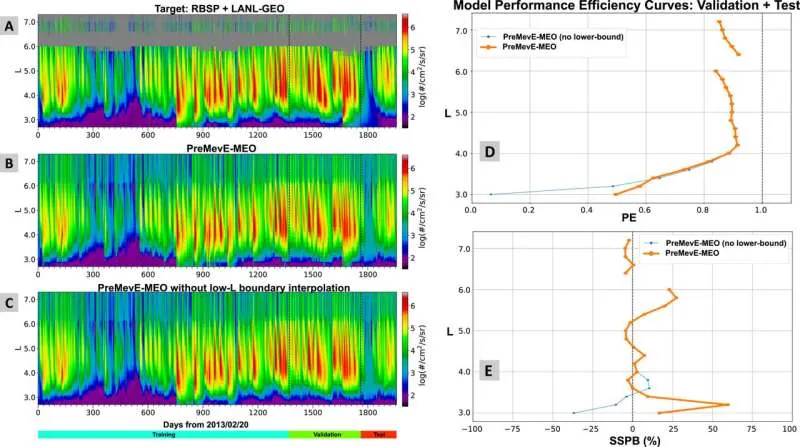AI-Enhanced Model Improves Space Weather Forecasting
Killer electrons that travel at nearly light speed inside the Earth’s Van Allen belts pose a significant threat to equipment in space by causing malfunctions in electronics. To address this issue, researchers from Los Alamos National Laboratory and the University of North Carolina at Chapel Hill have developed an AI-enhanced model to improve predictive capabilities for measuring electrons inside the Earth’s outer radiation belt.
Background and Importance
The Van Allen belts are a crucial zone that surrounds the planet and traps energetic charged particles. These electrons can cause malfunctions in electronics, posing a significant threat to satellites and other space-based equipment. Effective space weather forecasting is essential to protect these assets and ensure reliable communication and navigation services.
In recent years, advances in machine learning and artificial intelligence have enabled researchers to develop more accurate predictive models for space weather events. The collaboration between Los Alamos National Laboratory and the University of North Carolina at Chapel Hill marks an important step forward in improving space weather forecasting capabilities.
The New Model: Predictive MeV Electron-Medium Earth Orbit (PreMevE-MEO)
The team’s new forecasting capability, called Predictive MeV Electron-Medium Earth Orbit (PreMevE-MEO), can provide more accurate and efficient hourly forecasts. The model inputs include electrons observed by 12 medium-Earth-orbit GPS satellites and one Los Alamos geosynchronous-Earth-orbit satellite.
To develop the PreMevE-MEO model, researchers combined convolutional neural networks with transformers to improve performance. This innovative approach enables the model to make high-fidelity predictions driven by observations from longstanding space infrastructure in medium Earth orbit.
Key Features of the New Model
* Incorporates 12 Medium-Earth-Orbit GPS Satellites: The PreMevE-MEO model uses data from these satellites to improve predictive accuracy.
* Los Alamos Geosynchronous-Earth-Orbit Satellite Data: This unique dataset provides valuable information for the model’s development and validation.
* Convolutional Neural Networks with Transformers: The team’s innovative approach combines the strengths of both architectures to improve performance.
* High-Fidelity Predictions: The PreMevE-MEO model enables high-fidelity predictions driven by observations from longstanding space infrastructure.
Benefits and Implications
The new PreMevE-MEO model has significant benefits for space weather forecasting and satellite operations. By providing more accurate and efficient hourly forecasts, the model can help protect satellites and other space-based equipment from the threat of killer electrons.
In addition to its technical benefits, the development of the PreMevE-MEO model supports the National Space Weather Strategy and Action Plan. This implementation plan tasked agencies to identify and release historical data from satellites, ground-based observatories, and measurements throughout the electric power grid.
Conclusion
The collaboration between Los Alamos National Laboratory and the University of North Carolina at Chapel Hill has led to a significant advancement in space weather forecasting capabilities. The PreMevE-MEO model demonstrates the potential for AI-enhanced models to improve predictive accuracy and protect satellites from the threat of killer electrons.
By advancing our understanding of space weather events, researchers can develop more effective strategies for mitigating their impact on satellite operations and other space-based activities.
Future Directions
As the field of machine learning continues to evolve, researchers are likely to explore new approaches for improving space weather forecasting capabilities. The development of more advanced models, such as those incorporating multi-resolution data or using ensemble methods, will be critical for advancing our understanding of this complex phenomenon.
In addition to technical advancements, policymakers and stakeholders must continue to prioritize the release of historical data from satellites and other sources. This data is essential for developing accurate predictive models and ensuring the long-term sustainability of space weather forecasting capabilities.
Additional Resources
* National Space Weather Strategy and Action Plan
* Los Alamos National Laboratory’s Particle Data Portal
* University of North Carolina at Chapel Hill’s Machine Learning Research Group
By exploring new approaches to machine learning and incorporating valuable datasets, researchers can continue to advance our understanding of space weather events and develop more effective strategies for mitigating their impact on satellite operations and other space-based activities.

0 Comments